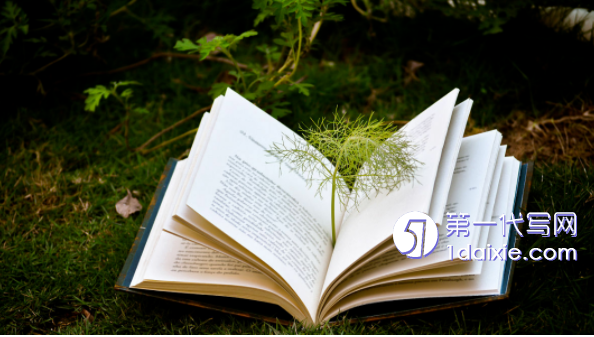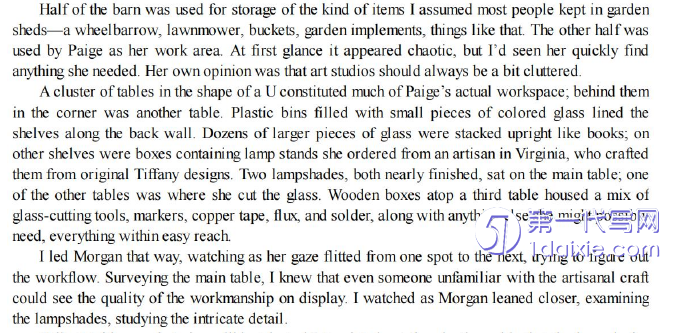本文是一篇英语毕业论文,笔者运用多种翻译方法及技巧,对选取的典型案例的翻译进行了分析。目的原则是翻译的首要原则,在目的原则的指导下,使用四字结构和转移的翻译技巧,使文本更加符合受众的阅读习惯,使目的语读者获得与源语读者相同的审美阅读体验;
Chapter 1 Task Description
1.1 Selection of the Source Text
Today,novels are one of the most popular genres in popular literature.It is not onlysought after by most adult readers,but also attracts the attention of a large number ofyoung readers.As China continues to open up to the outside world,more and moreforeign novels have been translated into Chinese and introduced to China.The translationquality of many foreign novels varies greatly,and are far from meeting the reading needsof young readers.Therefore,the translator decided to choose a novel as the source text ofthe translation practice.
Dreamland is a novel published in 2022 by Random House.The translator wasattracted by its story when reading this novel online.This is a romance novel about dreamand family responsibilities.It mainly tells a story of Colby facing the conflict betweenfamily responsibilities and his dream,and choosing to bravely take on familyresponsibilities.This novel is a warm and powerful story with well-developed characters,fascinating,and also has educational value.This translation practice uses the last threechapters of Dreamland is used as translation materials.It aims to introduce excellentforeign novels and have a positive impact on the healthy growth of Chinese young people,hopes that the target readers will have a better reading experience and be inspired by thisexcellent novel,and help promote the development and translation of domestic andforeign novels.

1.2 Analysis of the Source Text
Fully understanding the source text can make us translate better.Therefore,the firststep in translation is to analyze the source text.This section introduces the author and thesource text.
1.2.1 Introduction to the source text
Nicholas Sparks,born in 1965,is a famous American New York Times bestsellingauthor,and is one of the world’s most beloved storytellers.His novels are romantic instyle,with pure and romantic love stories as the main line,and are widely praised amongreaders.He is called“the King of Pure Romance”.His books have been published inmore than fifty languages with over 150 million copies sold worldwide,and eleven ofthem have been adopted into films,such as Notebook(1996)and The Love Diaries(1996).
Nicholas Sparks is very good at describing the conflicts and emotions betweenfamily members,and even better at describing the emotional feelings between lovers.Thewriting style is simple and unpretentious,the article is smooth and readable.NicholasSparks focuses on traditional themes.While romance played a role in his writing,Sparksexplored more serious themes such as loneliness,responsibility,and growth.So his booksare not only readable,but also instructive.
Chapter 2 Theoretical Framework
2.1 Development of the Skopos Theory
The Skopos theory has continuity and inheritance in content at various stages ofdevelopment.Generally speaking,the theories of four representative figures,KatharinaReiss,Hans J·Vermeer,Justa Holz Manttari and Christiane Nord,are the main researchobjects:
The first stage is Reiss’text type and translation criticism model:Reiss’text typetheory is is envisaged within a theory of norms.In 1971,she wrote in her bookMoeglichkeiten und Grenzen der Uebersetzungscritik,Kategorien und Kriterien fuer einesachgerechte Beurteilung von Uebersetzungen,she initially proposed the functionaltheory of translation,and focused on different text types and proposed correspondingstrategies and standards,thus successfully combining the standards of language functionand the standard of pragmatic function,and proposing a relatively objective evaluationsystem.Reiss believes that when translating,the text type must be first determined,andthen determine the translation methods.The translation methods should be consistentwith the text type(Hu,2008).
The second stage is Hans J·Vermeer’s Skopos theory and its extended theory:Reiss’student Vermeer continued and developed the functional theory of translation andproposed Skopos theory,the foundation theory of functional translation theory,in whichthe essence of translation was redefined.It provides a reflection and definition thattranslation is a purposeful communicative action of human beings,clearly points out theobjective fact that the purpose of translation determines the translation strategy,and putsforward the concept of translation instructions.According to Skopos theory,translation,on the one hand,has a very clear aim and functions as a form of cross-culturalcommunication.
2.2 Three Rules of the Skopos Theory
The three rules of the Skopos theory are skopos rule,coherence rule,and fidelityrule.The following is a detailed introduction to the three rules.
Firstly,the skopos rule is the highest criterion and the decisive principle.Vermeerbelieves that“translation/speaking/writing must enable the translation or text toperform its function in its environment and to perform its due effect on the person whouses it”(Peng,2008).The skopos of translation comes from the translation requirementsspecified by the initiator of the translation activity,which includes the purpose of thetranslation,the source text,the translation,the recipient,the time,place,situation,communication medium,and the functions of the translation.Another important point isthat the purpose principle takes into account the recipient of the translation because therecipient of the translation has the greatest influence on the formulation of the purpose ofthe translation.That is to say,the purpose of translation is to translate satisfy the intentionof a specific target audience.
Secondly,the coherence rule means that the target language text should have acertain degree of logic and readability.The translation must be readable and widelyaccepted in the culture in which the target language text is located,and it can truly fulfillits communicative purpose in the cultural atmosphere in which the target language text islocated.The coherence rule requires that the translation must comply with interlingualcoherence.The target language text is actually the source of information provided by thetranslator to the final target language reader.At the same time,the translator shouldprovide the target language readers with a coherent source of information that can berecognized and understood based on the actual purpose and the cultural background ofthe target readers(Nord,2001).
Chapter 3 Translation Process ......................... 9
3.1 Pre-translation Preparation ................................ 9
3.2 While-translation Procedure ............................. 10
Chapter 4 Case Analysis .............................. 12
4.1 Application of the Skopos Rule .................................. 12
4.1.1 Four-character structure ............................ 12
4.1.2 Transposing ................................ 15
Chapter 5 Conclusion ........................... 31
5.1 Major Gains........................................... 31
5.2 Limitations .................................... 32
Chapter 4 Case Analysis
4.1 Application of the Skopos Rule
Among the three rules of Skopos theory,the skopos rule is the first rule to befollowed in translation.The skopos rule means that the translation should be able tofunction in the context and culture of the target language in the way expected by therecipients of the target language(Zhang,2004).First of all,the translation enables thetarget language readers to better understand the content of the original text.Secondly,translation,as a means of cultural communication,can promote communication betweendifferent languages and cultures.Finally,the communicative function of the translationfor the target language readers is also reflected in its promotion of language learning.Forthose learning other languages,translations can serve as a learning tool to help themunderstand the grammar,structure,and vocabulary of the other language.The purpose oftranslation decides on translation methods and strategies(Reiss&Vermeer,2014).

Chapter 5 Conclusion
5.1 Major Gains
First,a lot of information about romance novel has been acquired through theapplication of Skopos theory to the study of translation of this expressive text.What’smore,the translator’s translation ability has been improved,and have accumulated theirexperience in translation,which allows her to translate flexibly.
Secondly,in the translation practice,the main thing is the essential conversionbetween English and Chinese languages.In this way,we can get the authentic translatedversion.Translation is an internal communication between different languages,whichrequires the translator to fully understand the differences between English and Chineselanguages during the translation process,including the differences between English andChinese language culture and Chinese and western ways of thinking.After becomingfamiliar with the differences between English and Chinese languages,the translatorconducts in-depth research on the changes between Chinese and English translations,takes advantage of the expression of the target language,and makes better translationsfrom the perspective of the target readers.
Through translation practice,it has been shown that translation theory is necessaryfor translators to obtain better translated texts.Skopos theory plays an important role intranslation.After analyzing the characteristics of the source text,reading a large numberof literature related to Skopos theory and its three rules and various translation techniqueswere flexibly applied in novel translation,and found that three rules of Skopos theory aresuitable for guiding the translation of expressive text.Therefore,under the guidance of the three rules of Skopos theory,appropriate translation techniques are chosen fortranslation and research analysis.This translation practice shows that Skopos theory issuitable for the translation of expressive texts.
reference(omitted)
